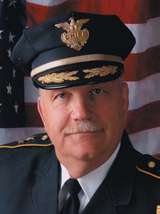 The opportunity to serve as your president has provided me with one of the most challenging and rewarding opportunities of my law enforcement career. Thank you for your support of me over the years and your continued service to the IACP and this honorable and noble profession.
The opportunity to serve as your president has provided me with one of the most challenging and rewarding opportunities of my law enforcement career. Thank you for your support of me over the years and your continued service to the IACP and this honorable and noble profession.
Throughout this year, the IACP has continued its tradition of leadership in law enforcement, providing law enforcement executives with the tools, information, and programs that they need to succeed.
I draw your attention to just a few highlights of this year and urge you to visit the www.theiacp.org for information on the numerous other projects under way at IACP.
Taking Command Initiative
The IACP Taking Command Initiative brought together the IACP Executive Committee and IACP Board of Officers to deliberate on the state of homeland security in the United States, the effectiveness of federal efforts since 2001, and what steps should be taken to improve our collective security.
The result of these deliberations is the IACP report From Hometown Security to Homeland Security: IACP’s Principles for a Locally Designed and Nationally Coordinated Homeland Security Strategy.
Since the publication of this report, the IACP, through its sections and committees, has begun work to develop a blueprint that will lead to a homeland security strategy that is locally designed and nationally coordinated.
IACP International Activities
The critical importance of IACP’s international efforts has never been clearer than today, as law enforcement agencies worldwide work to ensure that international criminals and terrorists are not able to evade justice by simply crossing a border.
Earlier this year, the IACP hosted its 22nd European policing conference in Paris and later this year will host its Fifth South American Policing Conference in Foz do Iguacu, Brazil. In addition, the IACP has continued to raise our international profile by sending small leadership delegations to international policing conferences such as the Istanbul Conference on Democracy and Global Security and others.
Electro-muscular Disruption Technology Executive Brief
In response to increasing concerns over the safety of electro-muscular disruption technology (EMDT) weapons, as well as the liability and risks associated with deployment of stun guns, the IACP issued an executive brief called “Electro-Muscular Disruption Technology: A Nine-Step Strategy for Effective Deployment” to inform law enforcement leadership on deployment challenges surrounding this technology. The executive brief offered a step-by-step guide to aid law enforcement agencies in selecting, acquiring, and using EMDT. The brief offers police agencies a framework for developing safe and sensible deployment and management plans for stun guns.
National Law Enforcement Leadership Institute on Violence Against Women
The IACP held its first Leadership Institute in 2005. The institute is an unprecedented opportunity for law enforcement executives to assess their agency’s current response to crimes of violence against women and improve their ability to meet the needs of the community. Four more institutes are scheduled for 2006.
Police Chiefs Desk Reference
The IACP Police Chiefs Desk Reference, a product of the New Chief Mentoring Project in the Services, Support, and Technical Assistance to Smaller Police Departments Program, was made available earlier this year. This guide for newly appointed police leaders contains sections on IACP resources, ethics, leadership, policy and procedures, best practices guides, funding, accreditation, state associations, and much more.
Finally, I want to express my deep appreciation to professional colleagues, friends, the police professionals of the Hartford Police Department, the community of Hartford, and my family and friends. All of you have enabled me to take on this tremendous challenge and experience it to the fullest. I look forward to continuing to serve the association in whatever capacity that is needed.
I hope to see many of you at the conference as we begin another exciting chapter in the long and distinguished history of IACP. ■


